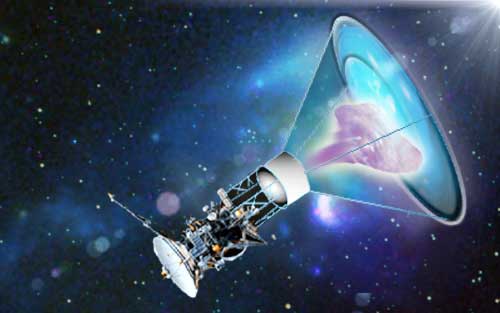NASA’s Institute for Advanced Concepts is in the midst of its 6th annual meeting, at the Grand Hyatt in Seattle. For interstellar theorists, the chief attraction this time around is Steve Howe’s presentation “Antimatter Driven Sail for Deep Space Missions.” The co-founder and chief executive officer of Hbar Technologies, LLC based in Chicago, Howe has devised a Kuiper Belt mission using a uranium-infused sail that would be driven by a cloud of anti-hydrogen released from the spacecraft.

Left: A cloud of anti-hydrogen drifts towards the uranium-infused sail. CREDIT: Hbar Technologies, LLC/Elizabeth Lagana
Sails and nuclear reactions have been paired before; in particular, in Johndale Solem’s Project Minerva, which posited setting off a nuclear explosion behind the sail to drive a spacecraft. Howe’s idea was to use nano-explosions on the sail itself. The sail would be a mixture of graphite and a new carbon-fiber material commonly known as carbon-carbon fused together, with tiny amounts of uranium impregnated in the material. And rather than a kilometers-wide sail, the energies released in this design mean that Howe can get away with a sail as small as five meters in diameter.
When I talked to Howe about the antimatter sail last year, he explained how the antimatter cloud would reach the sail surface: “The idea here is that you don’t need to give much energy, if any, to the anti-protons,” Howe said. “All they have to do is drift across and hit the sail with almost zero speed. They will find the uranium and cause it to fission. You don’t have to have accelerators to boost the antimatter pellets up to speed; you just release them and they more or less evaporate. And by the time cloud reaches the sail, it’s distributed across the diameter of the sail.”
The antimatter reacts with the uranium to produce neutrons and various secondary emissions, fission fragments that leave the sail at enormous speeds. The push is essentially a nuclear-stimulated ablation, which is what NASA’s John Cole described it as when I talked to him about Howe’s idea at Marshall Space Flight Center.
Cole sees real possibilities in Howe’s work. “The specific power there is something on the order of 2000 kilowatts per kilogram, which is the highest I’ve ever seen. If we can get ten kilowatts per kilogram, we can have human missions to the outer planets, with round trip times of two or three years. And,” Cole continued, “2000 kilowatts per kilogram is just enormous. So even if Howe is an order of magnitude off, even two orders of magnitude off, a factor of 100, he is still in the realm of where we can have human exploration of the outer planets.”
As for interstellar work, the challenge is to create and store enough antimatter. 30 milligrams of the stuff would seem to suffice for a Kuiper Belt mission, but Alpha Centauri would call for tens of grams. That’s not possible today, but high-capacity storage of antimatter is under intense study at Marshall Space Flight Center and other venues.
Howe’s continuing work on the antimatter sail has received Phase II NIAC funding. You can read more about the concept in the Hbar Technologies propulsion pages.

